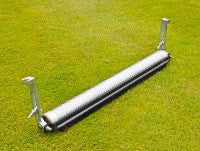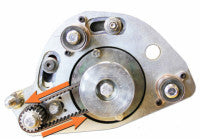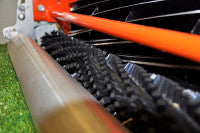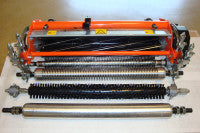Turf Groomers & Brushes

The use of brushes and grooming tools is certainly nothing new to the professional turf manager. Brush and comb sets have been an accessory to the Ransomes Certes mowers since the 1930s, and this somewhat basic groomer and static brush continue to be sold today. What has changed is the variety of accessories available to the modern professional and the turf management opportunities they provide.
Turf Groomers
Turf groomers were developed in the USA during the 1980s to meet the demand for a daily management tool for their fast growing turf species. The turf groomer is an accessory, fitted to a standard cutting unit and powered by a shaft with vertical cutting blades, usually set at either ¼" or ½" spacings across the width of cut. (Greens mowers use a ¼" spacing, whilst tees and fairways use the wider ½" spacing). The groomer blades are much smaller than the size of the cylinder, and the shaft spins at around 3000 rpm to provide a fast vertical cutting action in front of the cylinder. The working height of the groomer should be a precision adjustment, and all groomers need to have the facility to quickly raise the blades clear of the turf, when not required, and then be lowered back to the original working height without readjustment of the assembly. Groomers are usually set lower than the mowing height, so they bring up material which would normally pass under the mower blades.

I use the term height, instead of depth deliberately. The working height of a turf groomer should be no more than half the mowing height. So, a mower set at a 4mm height of cut, would have groomers set somewhere between 4mm and 2mm, with 2mm being the max depth achievable, not necessarily the target depth. The right depth on your turf depends on your sward mix and ground conditions. This is a grooming tool, not a renovation device!
If your turf has not been regularly groomed in the past, then set your new groomer units high to begin with and gradually lower into the sward over a period of a few weeks, until you achieve the surface results you are looking for. This not only avoids adding stress to the greens, but it also reduces undue stress to the mower as well!
The Results

One drawback to the early designs was wear on the mechanism, making accurate adjustment difficult, and failure of the clutch and belt drive systems, making them expensive to maintain. Thankfully, the later versions of groomers have removed, or reduced, these issues to leave us with significantly better, more reliable units.

Bi-Directional
The latest trend is to have a groomer which is bi-directional. With a double edged groomer blade, these units can run with the cylinder, or against it, giving real control over the aggression of the unit and the amount of material removed from the surface. Directional control with precise depth adjustment has really brought the turf groomer up to date.

Brushes
We have used brushes on greens for probably as long as we have used cylinders to cut fine turf. Raising lateral growth to the cylinder, removing debris from the surface and working in topdressing are classic reasons to use a turf brush. Brushing, much like grooming, is a mechanical maintenance process which can add to the quality of the surface, or detract from it if overdone.
There are a wide range of brush options on the market, from towed and mounted, fixed or powered brushes, cassette system units which replace the cutting units, fixed brushes fitted between the front roller and the cylinder, and brush alternatives to turf groomers. So, whether you want to use a brush as part of renovation, surface maintenance or daily preparation, there is a brush option that's designed for just that.

With a selection of bristle stiffness, and the option to reverse the brush direction, this is a real step forward.
Brush Selection
The stiffness of the brush, and the working height and aggression of the brush, all need to be carefully considered, if you are to achieve the desired results. It would be realistic perhaps to suggest using only soft bristles on fine fescues, and perhaps medium bristles for bents and most other grasses. Stiff bristle brushes can be very aggressive, which is great for removing material, (prior to overseeding or renovation programmes perhaps), or for use on more aggressive turf grasses, such as Bermuda or Zoysia, but perhaps not for general use in Northern Europe.

The potential benefits from using a groomer unit brush are its flexibility and the control the turf manager has over the results. One setting which has produced consistently good results is to reverse the brush direction and set it at the mowing height. This will brush and lift all leaves up to the cylinder and give a very fine cut, resulting in a faster, truer playing surface. The real benefit here is that any bruising to the leaf is removed by the mower, so all that is left is perfectly cut and healthy sward. The brushing action also leaves a clearly defined stripe, so the after cut appearance is improved - providing, of course, that the cutting unit is sharp and correctly adjusted!
Conclusions
Using either turf groomers or turf brushes can produce a better, truer and faster finish on your fine turf. However, as with all tools, it's really about understanding what they can do for you, and using them as part of a complete management programme. Including light grooming or brushing into the daily mowing regime can assist in producing a better turf surface.
